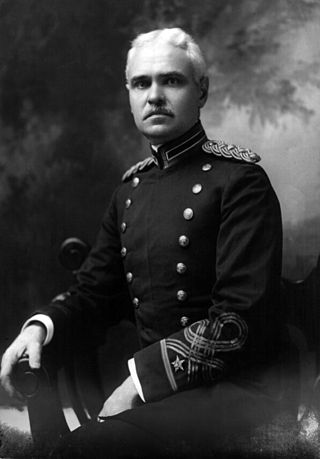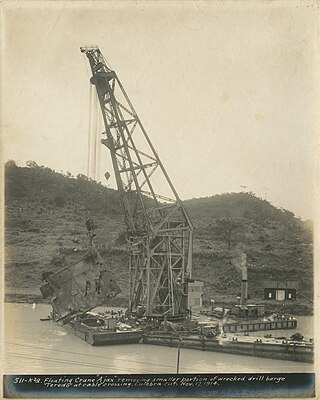
George Washington Goethals was a United States Army general and civil engineer, best known for his administration and supervision of the construction and the opening of the Panama Canal. He was the State Engineer of New Jersey and the Acting Quartermaster General of the United States Army.

The Panama Canal Zone, also simply known as the Canal Zone, was a concession of the United States located in the Isthmus of Panama that existed from 1903 to 1979. It consisted of the Panama Canal and an area generally extending five miles (8 km) on each side of the centerline, but excluding Panama City and Colón. Its capital was Balboa.
The Gatun Dam is an earthen dam across the Chagres River in Panama, near the town of Gatun. The dam, constructed between 1907 and 1913, is a crucial element of the Panama Canal; it impounds the artificial Gatun Lake, which carries ships 33 kilometres (21 mi) of their transit across the Isthmus of Panama. In addition, a hydro-electric generating station at the dam generates electricity which is used to operate the locks and other equipment in the canal.

The Culebra Cut, formerly called Gaillard Cut, is an artificial valley that cuts through the Continental Divide in Panama. The cut forms part of the Panama Canal, linking Gatun Lake, and thereby the Atlantic Ocean, to the Gulf of Panama and hence the Pacific Ocean. It is 7.8 miles (12.6 km) from the Pedro Miguel lock on the Pacific side to the Chagres River arm of Lake Gatun, with a water level 85 feet (26 m) above sea level.

The idea of the Panama Canal dates back to 1513, when the Spanish conquistador Vasco Núñez de Balboa first crossed the Isthmus of Panama. This narrow land bridge between North and South America was a fine location to dig a water passage between the Atlantic and Pacific Oceans. The earliest European colonists recognized this, and several proposals for the construction of a canal were made.

Chester Harding was an American civil engineer who managed the construction of Gatun locks (1907-1913) and later was Governor of the Panama Canal Zone from 1917 to 1921.

Joseph Cowles Mehaffey was a major general in the United States Army. As a member of the Army Corps of Engineers, he was the consulting engineer on the Arlington Memorial Bridge in Washington, D.C.; helped renovate the White House; and served as a supervising engineer for the Works Progress Administration during the Great Depression. He was assigned in 1941 as maintenance engineer of the Panama Canal, and was governor of the Panama Canal Zone from 1944 to 1948.

George Whitefield Davis was an engineer and major general in the United States Army. He also served as a military governor of Puerto Rico and as the first military Governor of the Panama Canal Zone.
Gaillards is a naval term for the forecastle and quarterdeck (together) on a sailing warship.

Postage stamps and postal history of the Canal Zone is a subject that covers the postal system, postage stamps used and mail sent to and from the Panama Canal Zone from 1904 up until October 1978, after the United States relinquished its authority of the Zone in compliance with the treaty it reached with Panama.

Henry Larcom Abbot was a military engineer and career officer in the United States Army. He served in the Union Army during the American Civil War and was appointed brevet brigadier general of volunteers for his contributions in engineering and artillery. In 1866 he received additional brevet appointments as major general of volunteers and brigadier general in the Regular Army. He conducted several scientific studies of the Mississippi River with captain, later Major General Andrew A. Humphreys. After his retirement, Abbot served as a consultant for the locks on the Panama Canal. He was elected a Fellow of the American Academy of Arts and Sciences in 1863.

Gamboa is a small town in corregimiento of Cristóbal in the Colón Province, Panama close to the Panama Canal and the Chagres River. It was one of a handful of permanent Canal Zone townships, built to house employees of the Panama Canal and their dependents. The name Gamboa is the name of a tree of the quince family.

Paraíso is a town in the Republic of Panama, located just north of the Panama Canal's Pedro Miguel Locks. It was a vibrant township of the old Canal Zone, though it was segregated for most of its history.

Major General William Luther Sibert was a senior United States Army officer who commanded the 1st Division on the Western Front during World War I.

Ernest “Red” Hallen (1875–1947) was an American photographer, noted for his 30 years of work as the official photographer of the Panama Canal.

Edward Burr was an American general and engineer in the United States Army who served in the Spanish–American War and World War I. He is best known for his service to the Army Corps of Engineers.

Ajax is a floating crane built to move and install the canal locks and other large parts of the Panama Canal. Ajax also helped in ship repairs and clearing the canal as needed. Ajax and her identical sister crane, the Hercules, were the largest floating cranes at time of completion, able to install the massive Panama Canal locks. Ajax could lift a maximum of 250 tons to a height of 21 feet (6.40 m), with a close reach. At Ajax's far reach she could lift a maximum of 100 tons. Ajax and Hercules were built by Deutsche Maschinenbau AG (1910–1977) . After the Ajax and Hercules, Deutsche Maschinenbau AG later made the Langer Heinrich, or Long Henry in 1915, in use for 100 years.

The Panama Canal Department was a department of the United States Army, responsible for the defense of the Panama Canal Zone between 1917 and 1947.

William Wright Harts was a United States Army officer in the late 19th and early 20th centuries. He served in several conflicts and capacities, including in World War I, and he received the Army Distinguished Service Medal among other awards.

Naval Base Panama Canal Zone refers to a number of United States Navy bases used during World War II to both protect the Panama Canal and the key shipping lanes around the Panama Canal Zone. Bases were built and operated on the Atlantic Ocean side and the Pacific Ocean side. The main Naval Base at the Panama Canal was the Naval Station Coco Solo that had been in operation since 1918.


















